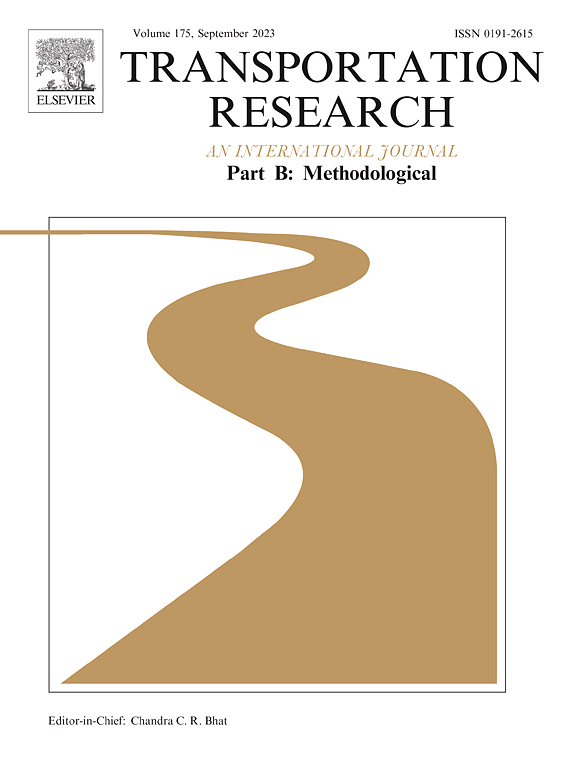Unveiling network capacity potential with imminent supply information part I: Theoretical derivation
IF 5.8
1区 工程技术
Q1 ECONOMICS
引用次数: 0
Abstract
An urban network’s supply capability is notably impacted by the operational efficiency of its bottlenecks, namely the intersections. An essential and powerful metric for describing a network’s overall supply performance is the capacity region (CR), which represents all potential combinations of capacities for different intersection movements. This study explores the impact of imminent saturation flow rate (I-SFR) information on the CR of traffic networks. The work is separated into Part I and Part II to prevent a lengthy paper. Specifically, in Part I, we systematically formulate the conflicting relationship between different movements using greatest conflicting group and green ratio constraints, formally define the dominating relationship between different CRs, and theoretically demonstrate 1) how knowing the accurate I-SFRs of additional conflicting movements can expand the CR, resulting in a larger CR that dominates the original one, and 2) how improving the prediction accuracy of observed movements’ I-SFRs can enlarge the CR. Part II will develop a “ruler” – the BackPressure control with partial I-SFR information – to measure the changes in CR and validate the theories of Part I through simulation experiments.
揭示即将供给信息下的网络容量潜力第一部分:理论推导
城市网络的供电能力受到其瓶颈(即交叉口)的运行效率的显著影响。容量区域(CR)是描述路网整体供应性能的一个重要而有力的指标,它代表了不同交叉口运动的所有潜在容量组合。本研究探讨了临近饱和流率(I-SFR)信息对交通网络CR的影响。为避免论文冗长,本文分为第一部分和第二部分。具体而言,在第一部分中,我们使用最大冲突群体和绿比约束系统地表述了不同运动之间的冲突关系,正式定义了不同运动之间的主导关系,并从理论上论证了1)如何知道额外冲突运动的准确I- sfrs可以扩大CR,从而导致更大的CR支配原始的CR;第二部分将开发一种“尺子”——具有部分I- sfr信息的背压控制,以测量CR的变化,并通过仿真实验验证第一部分的理论。
本文章由计算机程序翻译,如有差异,请以英文原文为准。
求助全文
约1分钟内获得全文
求助全文
来源期刊
CiteScore
12.40
自引率
8.80%
发文量
143
审稿时长
14.1 weeks
期刊介绍:
Transportation Research: Part B publishes papers on all methodological aspects of the subject, particularly those that require mathematical analysis. The general theme of the journal is the development and solution of problems that are adequately motivated to deal with important aspects of the design and/or analysis of transportation systems. Areas covered include: traffic flow; design and analysis of transportation networks; control and scheduling; optimization; queuing theory; logistics; supply chains; development and application of statistical, econometric and mathematical models to address transportation problems; cost models; pricing and/or investment; traveler or shipper behavior; cost-benefit methodologies.

 求助内容:
求助内容: 应助结果提醒方式:
应助结果提醒方式:


